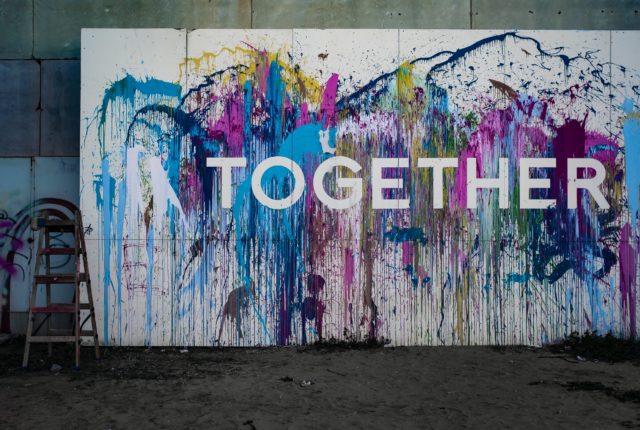According to Gallup, 65% of the U.S. workforce is not actively engaged, and this results in about $300 billion in lost productivity every year. These employees are indifferent and lack inspiration. At the core of this problem lies workplace conflicts.
When employees are in conflict with either their organization or their colleagues, they lose inspiration, and their commitment to the attainment of organizational goals declines. Thus, effective conflict resolution is a vital part of enhancing employee engagement in modern organizations.
Pollack Peacebuilding prides itself on being a trailblazer in the conflict resolution specialty. We offer a variety of peacebuilding services, all geared toward restoring peace to your employee teams. Our custom conflict transformation services will help you address a current conflict that is taking a toll on your team’s performance.
Our conflict resolution, conflict management, and communication skills coaching packages come in handy in preventing future conflicts and cultivating a culture of cooperation and collaboration within your teams.
What is Employee Engagement?
Employees are the most valuable assets in any organization. Many organizations deem their employees to be the first customers. Employee knowledge, expertise, and skills cannot be substituted, yet these attributes enable employees to drive the organization’s mission, whether in product or service delivery.
This explains why organizations place great emphasis on employee welfare, for this is directly tied to the contribution that these employees make to an organization. Organizations, however, need to ensure that employees remain actively engaged and committed to their work and workplace for maximum productivity. This, in turn, enhances overall organizational performance and attainment of goals.
Definition of Employee Engagement
We define employee engagement as the strength of the mental and emotional connection that employees have for their work, the team members that they work with, and the organization that they work for. Simply put, this is how mentally and emotionally invested employees are toward their work organizational goals.
Engaged employees are committed to their work and productivity as well as display and support a positive company culture. Such employees are not only focused on the paycheck but are passionate about their work and helping an organization attain its goals. As a measure of the strength that an employee has with his workplace, engagement can be used as an indicator of workplace health.
Why is Employee Engagement Important?
Employee engagement matters because it is directly linked to productivity. Engagement ensures that whatever employees do is infused with purpose, enthusiasm, and energy. Engaged employees are satisfied employees, and they are content with their contribution and impact on the organization. Also, employee engagement boosts employee retention and lowers employee turnover, which not only enables organizations to retain talent but also facilitates major cost savings.
Company culture is important, and one of the companies that takes employee engagement very seriously is Microsoft. This tech giant employs a highly effective employee engagement strategy pegged on professional development, periodic employee engagement surveys, effective communication, training and development programs, and team-building activities to actively engage its employees at all times.
Improving the company culture at Microsoft involves prioritizing employees, ensuring they are not only well remunerated but also striking a healthy work-life balance. A notable employee engagement program at Microsoft is AskHR, an online platform that supports inquiries to Microsoft’s HR department.
Through this program, the senior leaders at Microsoft get feedback on a variety of issues that affect employee satisfaction and the overall success of the organization. For businesses to succeed in the highly competitive business environment, a robust employee engagement model is necessary.
Effective Conflict Resolution and Sustained Employee Engagement
Conflict stands out as one of the main deterrents to employee engagement. At Pollack Peacebuilding, we define conflict as a mental struggle resulting from opposing needs, interests, values, or demands. Some common sources of conflict in the modern workplace include:
- Personality differences
- Task ambiguity
- Resource scarcity
- Communication breakdowns
- Competing priorities
Conflict takes a mental toll on engaged employees, lowering their overall commitment. Conflicts are inevitable in any workplace, but how they are handled is what makes the big difference.
Research shows that there is a direct connection between the effectiveness of conflict resolution initiatives and the level of employee engagement. A business environment that is less prone to conflicts enhances employee engagement and overall productivity. However, since conflicts are inevitable, what you need is a sound conflict management plan.
While trying to resolve conflicts in the workplace, it is important to note that these occurrences can either be constructive or destructive, depending on how they are approached. Constructive conflict resolution will stimulate innovation, learning, and creativity. On the other hand, destructive conflict resolution erodes trust, lowers commitment, and hinders team collaboration.
Pollack Peacebuilding recommends having an experienced peace builder help you with conflict resolution. We are an experienced provider of conflict resolution services. We have helped many companies shape their conflict resolution systems for better business outcomes.

Components of Employee Engagement
Organizations desire highly engaged employees. However, there is only a limited number of organizations that consistently sustain high levels of employee engagement. The main challenge is developing an employee engagement strategy that aligns with organizational culture and goals.
To improve employee engagement, organizations must implement well-thought-out employee engagement initiatives that boost employee morale and overall job satisfaction. However, a highly effective employee engagement strategy is not easy to develop, and HR professionals often struggle with balancing the various components of employee engagement.
So, what does good employee engagement comprise?
1. Strong and Effective Communication
Communication facilitates the flow of information and feedback within an organization. Communication thus has a major bearing on organizational success. Effective communication facilitates the building of strong relationships between employees and their management by encouraging open, two-way communication. The trust on which these healthy relationships are built can only be built through transparent and open two-way communication.
According to the Harvard Business Review, an engaged employee identifies with their organization, feels energized to work, and is committed to their employer. This internalization of organizational culture and values is possible only through effective communication.
A 2020 study by Brunel University London established that internal communication strategies, such as consistent feedback, information sharing, and open communication channels, boost employee engagement by building trust and strengthening collaborative bonds in the workplace.
Notably, effective communication informs leadership. An organization’s vision comprises wider big-picture values and goals that must be conveyed effectively to stakeholders. Through effective two-way communication, senior leadership bridges feedback gaps to enhance mutual understanding of where an organization is headed and the best way to get there.
A 2020 Harvard Business Review report states that fostering a cohesive workplace environment through strong and effective communication is a sure way of making employees feel valued.
Organizations should embrace effective communication as an ongoing process to increase employee engagement. Our communication skills training and coaching packages are tailored to help companies cultivate a culture of effective communication.
Our training is dynamic, highly interactive, and geared toward improving communication while also mitigating workplace conflicts. Our training curriculum is designed to improve listening skills, emotional intelligence, and relationship building. Through this training, you will gain important employee engagement ideas through communication.
2. Effective Leadership
Research by Gallup shows that management alone accounts for up to 70% of the variance in team engagement. This research finding underscores the importance of effective leadership when it comes to employee engagement. Highly engaged employees are accountable and responsible for their actions-a trait that they acquire from their leaders.
Good leaders strive to make employees feel respected and valued. Such leaders make an effort to motivate and inspire employees to earn their trust and loyalty. Also, effective leaders consistently make an effort to appreciate and recognize employee contributions to organizational success.
When conflicts arise, good leaders will invite employees to conflict resolution forums, whether the conflicts are at the individual or team level. All this is possible when leaders embrace effective communication in the workplace.
3. Appreciate and Recognize Employees
Employees come to the workplace with personal aspirations and expectations. One of these expectations is that they will be properly compensated for the contribution they make to the organization. When employees feel that their effort is not recognized and effectively rewarded, then engagement levels dip, and productivity declines.
Since organizations differ, it is important to develop an employee recognition and reward system that matches the organization’s culture, beliefs, and values. This system should reward employees at both the individual and team levels.
The essence of rewarding employees at the individual level is that, at times, team-level rewards eclipse individual achievements. This lowers individual morale and commitment. A year-round employee recognition system would ensure that employee efforts are continuously rewarded, and this would increase employee engagement.
At Pollack Peacebuilding, we acknowledge the importance of employee recognition and reward. A 2022 employee engagement report by McKinsey reveals that more than 19 million employees have quit their jobs in the U.S. due to issues relating to rewards and appreciation.
The interesting part is that most of these employees who are leaving their workplaces are not poorly paid but generally feel that their efforts are not adequately appreciated. It is the simple thing that most employers are missing. Praises, personalized gifts, flexible working conditions, incentives, and perks are some simple ways of recognizing and appreciating employees.
Pollack Peacebuilding can help you develop a successful employee engagement strategy that will be anchored on effective compensation for effort. It is not easy to increase employee engagement when employees do not feel appreciated for the effort they make to actualize organizational goals.
4. Personal and Professional Development
Employees expect to grow and advance both personally and in their careers. Personal and professional development creates an opportunity for employees to assess their skills and abilities, set life and professional goals, and act toward the realization of these goals.
We define personal development as self-improvement through activities that develop personal capabilities and potential. Also, personal development improves quality of life and facilitates the realization of personal aspirations. The goal of personal development is improving one’s mental, emotional, and social well-being.
In contrast, professional development is the advancement of the skills, traits, and competencies that contribute to overall success in the workplace. Professional development builds human capital, enhances employability, and has been established to be one of the best ways to increase employee engagement. Employers who create opportunities for their employees to advance their careers will improve employee engagement, while those who stagnate their employees face engagement problems.
One of the best employee engagement ideas, according to the Harvard Division of Continuing Education, is formal training programs. These formal training programs keep employees up to date with recent industry trends, create opportunities for employees to learn new skills, and help employees build their networks. Certificates of merit awarded after these formal training programs act as confidence builders in employees.
After years of working with clients in the peacebuilding specialty, we have established personal and professional development to be one of the conflict-prone areas of employee engagement.
First, there is a conflict between personal and professional values. Competing values can hinder personal and professional development goals and affect productivity. For example, an employee may be torn between staying at the workplace and working to help the organization attain its goals or going back to college to earn a degree and look for a better job. Again, an employee may be torn between going back to college to earn a second degree or spending more time with family.
The second common type of conflict in personal and professional development relates to the employer. At times, an employer will delay or refuse to promote personal growth and development. Financial constraints and understaffing are common reasons for this.
In this case, an employee will feel undervalued, and they will lose morale and motivation. Pollack Peacebuilding offers solutions to these and other types of conflicts relating to personal development. Our conflict de-escalation, communication, and peacemaking coaching programs are ideal for senior managers facing challenges in the execution of personal and professional development.
5. Clearly Defined Roles and Responsibilities
An entire organization runs on a set of clearly defined roles and responsibilities. A successful employee engagement strategy cannot be implemented if there is confusion about the delegation of duties. When roles and responsibilities are clearly pre-defined, the room for confusion and misunderstanding is minimized.
Clearly defined roles and responsibilities enable employees to contribute effectively for better business outcomes. Roles and responsibilities should be manageable, clear, and well-communicated.
According to Gallup, when leaders do not clearly define roles and responsibilities, then this creates distrust among team members. However, clearly defined roles and responsibilities encourage team members to look beyond their individual positions and to cultivate respect and value for one another.
Conflicts are common when it comes to the definition of roles and responsibilities. Many times, employees feel overwhelmed by the duties and responsibilities assigned to them, and this breeds resistance. Again, when roles and responsibilities are not clear, confusion arises, and this can easily bring conflict between employer and employee or between team members.
Senior managers need to find a way of handling this resistance or conflict without compromising their goals, relationships, and productivity. Clear and respectful communication and realistic expectations are vital to minimize conflicts.
When conflicts arise relating to roles and responsibilities, it is advisable to consult a conflict resolution expert. Pollack Peacebuilding has helped many employers resolve conflicts relating to the delegation of duties and responsibilities.

4 Employee Engagement Improvement Ideas for Organizations
Employee engagement does not happen by chance and requires massive investment. Creating a conducive work environment is one of the employee engagement ideas that every manager should consider. An engaged employee effectively contributes to a company’s success, and this justifies employee engagement efforts.
Pollack Peacebuilding offers a wide range of services to help you resolve conflict and keep employees engaged. Below are some important employee engagement hints that can help organizations fortify employee engagement.
1. Continuously Evaluate Employee Performance
You have to continuously monitor employee performance to understand their engagement levels. The Watson Wyatt’s WorkUSA Survey reports that engaged employees perform better than their less engaged counterparts.
Thus, employee performance is one of the most suitable key performance indicators of employee engagement. Workplace conflicts can take a toll on employee morale and motivation, significantly lowering performance. Managers should employ effective conflict resolution at all times to minimize conflict and encourage employee engagement.
Managers should opt for objective criteria to evaluate performance while keeping in mind that these evaluations should be used for career advancement discussions and not solely for compensation purposes.
Timeliness, including meeting deadlines and attaining set performance targets, is a good employee performance metric. The findings of employee performance evaluation will then be used to model an employee engagement system.
2. Implement an Employee Engagement Plan
Creating and maintaining an effective employee engagement plan involves several key strategies designed to engage employees and keep them motivated:
- Assign the Right Role: One of the primary drivers of employee engagement is ensuring employees’ roles align with their skills and career aspirations. When individuals are assigned roles that suit their strengths and interests, they are more likely to invest in their work. This strategy prevents employees from fixating solely on monetary incentives and helps to increase their intrinsic motivation. To implement this, managers should take time to understand each employee’s career goals, acting as mentors to guide them toward success.
- Offer Support and Encouragement: Never underestimate the power of positive reinforcement in the workplace. Providing support and showing appreciation for employees’ efforts are essential in creating a conducive environment for engaging employees. Celebrating small victories and offering constructive feedback can have a transformative impact on an employee’s perspective, which fosters a culture of confidence and self-assurance. Managers should regularly acknowledge employees’ strengths while also helping them overcome challenges.
- Provide Regular Training Opportunities: Investing in training and development is crucial for maintaining an engaged workforce. Companies should implement a planned approach to skill development, including technical competencies, business skills, and communication proficiency. When employees are trained to tackle challenges effectively, potential adversities turn into accomplishments, leading to greater job satisfaction. Investing in learning opportunities shows that the company values its employees’ growth, which can significantly improve employee engagement.
- Incorporate Regular Feedback Mechanisms: A well-structured employee engagement survey is one of the most effective tools for gauging engagement levels. Surveys like pulse checks, life-span assessments, and specific employee engagement surveys provide insights into employee morale, performance, and other drivers of employee engagement. Regular feedback helps identify disengaged employees and address their concerns promptly, converting dissatisfaction into proactive engagement. Honest feedback and open discussions build trust and respect within the team.
- Implement Employee Engagement Software: Utilizing employee engagement software like Qualtrics EmployeeXM can streamline the process of gathering and analyzing feedback in real time. This software provides management with ongoing insights into engagement levels across the organization, helping to identify areas for improvement quickly. The data collected allows companies to make informed decisions, ensuring that their employee engagement plan is always up-to-date and responsive to employees’ needs. The use of such technology enhances the company’s ability to engage employees effectively, making the overall engagement strategy more dynamic and flexible.
- Foster Transparent Communication: Open and transparent communication is essential for building trust between employees and management. Establishing clear channels where employees can voice their questions and concerns fosters a sense of inclusion and respect. Studies show that 74% of employees feel they miss out on important company news, so consistent communication helps keep employees engaged.
- Recognize Top Performers: Recognition is a powerful motivator. When a company acknowledges and rewards employee achievements, it boosts morale and job satisfaction. Organizations should recognize top performers regularly, whether weekly, monthly, or quarterly. Rewards can range from cash prizes and gift hampers to thank-you notes and extra days off.
- Encourage Accountability: Holding every team member accountable for their actions prevents disengaged employees from negatively impacting their more motivated colleagues. When employees feel they are solely responsible for their own success and contribution to the team, it creates a fair and balanced work environment.
- Balance Processes and Results: While focusing on results is important, an excessive obsession with outcomes can lead to employee burnout and resentment. Instead, leaders should concentrate on creating a meticulous process while allowing flexibility in workflows. This balanced approach helps prevent exhaustion and keeps engaged employees productive and satisfied.
- Continuously Modify the Engagement Plan: The employee engagement plan should be a dynamic, evolving strategy. Use feedback from employee engagement surveys to adjust the plan as necessary. Integrating insights on wellness, compensation, organizational culture, and career development ensures that the plan remains relevant and addresses the needs of both disengaged employees and those already engaged.
3. Promote Teamwork and Collaboration
Teamwork is meant to encourage cross-functional collaboration. According to Gallup, teams unlock opportunities for growth, boost productivity, and allow for smarter risk-taking. Teams thus lead to happier employees. However, setting up teams and sustaining team synergy is no mean feat. This is particularly a challenge when remote workers who do not engage physically are involved.
Remote workers find it more difficult to cultivate strong relations since there is limited communication and interaction. Differences in interests and goals often stir conflicts, and this compromises collaboration. Disagreements and arguments arise during team meetings, and this calls for management intervention.
Our conflict management training can help managers handle such conflict situations with ease and effectively check for team pulse. Corrective action, including mediation and counseling, should be taken to resolve any impending conflicts and boost employee engagement within teams.
4. Encourage Commitment to Long-Term Vision and Core Values
When employees and managers work together toward the attainment of organizational goals, success is inevitable. For this to happen, senior managers need to explain the company objectives, core values, and long-term vision with patience and clarity. This is particularly important for new hires who have no prior engagement with the organization.
Induction sessions should be centered around making the core values and long-term vision clear. For example, Forbes emphasizes the need for organizations to require all new employees to read the company’s handbook and then sign a compliance statement. This minimizes the risk of conflicts and confusion, which is a good way of improving employee engagement.
Senior management should make an effort to explain these core values to its employees from time to time so that they remain ingrained in employees’ minds.
Pollack Peacebuilding’s Approach to Employee Engagement and Conflict Transformation
Peacebuilding is not a walk in the park. It requires tact and massive investment in time. This is why you need to find an experienced and capable peacebuilder to help you resolve conflicts.
Apart from experience, you should also consider the approach that a peacebuilder uses to resolve conflicts. This approach should be compatible with your organization’s culture and peacebuilding goals. There is no one-size-fits-all approach to peacebuilding, but a peacebuilder should have a general approach to peacebuilding founded on their peacebuilding philosophy.
Pollack Peacebuilding prides itself on a highly effective peacebuilding approach that it has successfully employed in numerous peacebuilding instances. Our dedicated conflict transformation teams employ a set of highly effective methodologies to help resolve conflicts and foster employee engagement.
Our time-tested methodologies are based on sound organizational assessment and geared toward organizational culture optimization. Below is a brief review of our training, coaching, and mediation and facilitation methodologies.
Conflict Management Training
This conflict program is geared at imparting skills to managers to deal with conflicts. These include conflicts between employees as well as conflicts between employees and customers. The training is founded on the psychology behind conflict and revolves around the warning signs that are often ignored before conflicts escalate. Once managers manage and prevent conflicts, then an employee engagement strategy has a higher chance of succeeding.
“We were really pleased with the quality of the instruction and the hands-on activities that PPS designed for us. They really customized the presentation to our needs. We hope to continue to work with Pollack in the years to come.”
– Deron Chang, Director of Curricular Initiatives, Choate Rosemary Hall
De-Escalation Training
According to the RAND Corporation, workplace violence is on the rise, and this has necessitated de-escalation training. This training is founded on emotional control, which can help increase the safety of staff, visitors, and customers.
Managers and team leaders must be able to contain conflict escalation by effectively handling highly emotional employees and customers. When things get heated, the risk of violence is high. Violence is a deterrent to employee engagement since a violated employee or customer is mentally and emotionally disturbed.
Such employees feel disrespected and devalued, and this lowers their commitment and motivation. Conversely, conflict de-escalation encourages employees to come to a common ground and build strong relationships. This way, conflict de-escalation training drives employee engagement.
“As the CEO of a growing business, PPS has helped my corporation in several ways…all of which have translated into positive factors such as elevated productivity, a more contented and productive work environment, and, most importantly, a reduction of conflict and hostility between colleagues.”
– Alan Sitomer, CEO, Mastery Coding
Communication Training
Communication sits at the center of the conflict. While effective communication lowers the chances of conflict, ineffective communication increases the chances of conflict. One of the employee engagement strategies that we recommend to most of our clients is developing a sound communication plan.
Our communication training is geared toward improving communication and mitigating conflicts more efficiently. Some of the skills that we strive to impart include listening, empathetic listening, perspective-taking, relationship management, and emotional intelligence.
Clear communication is pivotal in relationship building, which is the number one element that makes life worth living. Strong relationships, on the other hand, engage employees by encouraging collaboration and minimizing conflict.
“We found such value in the program that we are now launching to our entire company! I would highly recommend PPS to anyone who is looking for development in conflict resolution and how to improve communication as a whole.”
– Kalli Blackwell Peterman, General Manager, Aveda Arts & Sciences Institutes
Coaching
Coaching is a more refined strategy that is more suited to employees who already have the skills and knowledge. Rather than teaching employees new concepts and skills, coaching is geared at helping employees or team members overcome a challenge that is preventing them from reaching their maximum potential.
Pollack Peacebuilding offers a conflict coaching program that incorporates both communication training and conflict management skills improvement through individualized coaching sessions. This coaching can be offered online in one-to-one sessions or group team coaching.
Some of the benefits of conflict coaching include increased productivity, improved wellness, and avoidance of legal damages. Increased wellness is an important factor that drives employee engagement. Once employee welfare is improved, then employees will feel valued and respected.
“Jeremy is great and has the ability to quickly identify core issues and help parties reach a resolution. Although he is supportive and understanding, he doesn’t allow parties to avoid confronting and dealing with the key challenges. Highly recommend.” – Edward Angwin, Attorney-at-Law
Mediation
We also employ the mediation technique to help in conflict resolution. This technique works best for conflicts that have escalated, in which case an experienced neutral third party is needed for resolution. The neutral third party helps the team members craft a workable, mutually acceptable resolution to resolve the issue at hand.
Our dedicated and experienced team members have effectively employed this technique to help resolve contract disputes between employers and employees. A mediation technique known as transformative mediation emerges as one of the best types of mediation for conflicts between employers and employees.
This type of mediation acts as an employee engagement strategy by resolving existing conflict and helping build strong relationships among team members.
“PPS was a big help in an HR issue at our 30-person firm where we felt we needed third-party objectivity without the heavy hand of a lawyer or investigator. Jeremy was able to assess the situation and gain the trust of both the employee and management and accurately assessed a workable path forward. Jeremy brokered an offer and compromise acceptable to both parties and our organization learned much from an experience that ultimately resulted in a more peaceful, harmonious workplace.”
– Peter Connery, Vice President, Applied Survey Research
Facilitation
Pollack Peacebuilding also offers facilitation services. Facilitation is necessary when there are burning issues that need to be addressed, critical decisions made, plans developed, and action plans implemented to resolve problems.
Our facilitators are trained individuals who help team members communicate effectively and build positive relationships to make the process a success. We offer facilitation services in conflict management and communication skills.
During facilitation, we strive to strengthen professional and personal bonds between team members as they work toward crafting and implementing plans. This way, our facilitation programs act as an employee engagement strategy that drives employee performance.
“Jeremy was integral in my growth with ending ‘wars’ of personal and professional conflicts. I adopted several stories of conflict that needed to be updated. With the help of Mr. Pollack, I have experienced a peaceful reboot. I feel a sense of freedom as I move on with my life.”
– Yusef Alexander, Principal, REAP Capital
Closing Remarks
Employee engagement is an area that organizations must take seriously, for it directly affects overall performance. Engaged employees drive organizational performance, while less engaged employees are likely to pull an organization down. At the center of employee engagement sits conflict management.
Workplace conflicts are inevitable, but these need to be resolved promptly to safeguard employee engagement. Pollack Peacebuilding offers assistance in conflict resolution and management through training and coaching programs. We also offer professional consultation services on conflict management and employee engagement.Our highly effective methodologies and qualified staff will help you resolve conflicts with ease for a more engaged workforce. Reach out to us today if you feel that there is some conflict scenario that is affecting employee engagement and pulling your organization back. Our services come in highly affordable, tailor-made packages that guarantee results in a few days.



